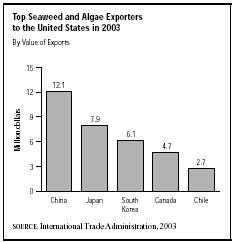SIC 0919
MISCELLANEOUS MARINE PRODUCTS
This industry classification covers establishments primarily engaged in miscellaneous fishing activities, such as catching or taking of miscellaneous marine plants and animals. Plants and animals covered under this code include seaweed, sponges, sea urchins, terrapins, turtles, and frogs. Cultured pearl production also falls under this classification.
NAICS Code(s)
114119 (Other Marine Fishing)
111998 (All Other Miscellaneous Crop Farming)
The primary marine animal featured under this heading is the turtle. Turtles became popular for meat and soup shortly after Columbus discovered the New World. By 1878 an estimated 15,000 green turtles were shipped annually from the Caribbean to European markets. The market for the turtle began to wane in the 1990s as environmental concerns that the species was nearing extinction mounted.
The turtle's popularity as a meal item had created a serious threat to its ability to sustain its population by the turn of the twenty-first century. In addition to risks associated with over-harvesting and habitat loss, thousands of turtles have been injured or drowned as a result of commercial fishing operations.
Many species of sea turtles, such as the hawksbill turtle, Olive ridley, Kemp's ridley, and the green turtle, have been listed as endangered or threatened. In 1973 the Convention on International Trade in Endangered Species of Wild Fauna and Flora drafted a resolution to prohibit the trade of endangered or threatened species including the imperiled sea turtles. The agreement was signed by 95 nations. To further protect the species, the U.S. Department of State began requiring shrimp fisherman to use turtle excluder devices (TEDs) to protect turtles from being killed in shrimp trawls. In 2002, the U.S. government certified the shrimp harvesting practices of 41 countries as turtle-safe.
The diamondback terrapin population has also dwindled, a victim of over-harvesting and diminished habitat. The diamondback terrapin, which lives in

estuaries and salt marshes along the eastern seaboard and through the Gulf of Mexico region, is regarded by many culinary experts as the best tasting species of turtle.
In 1920 the population of diamondback terrapins plummeted, spurring the institution of regulatory measures designed to protect it. Governmental agencies undertook breeding efforts to reestablish it in some areas. During the 1960s the diamondback population started to show signs of recovery; however, market demand also increased. In 1989 New York established more stringent regulations defining the size and season for taking turtles. Some environmentalists charge that the rules are inadequate, and they predict another population crash.
Another well-known miscellaneous marine product is seaweed. The two centers of seaweed production in the United States are located in New England and California. Although seaweed is used as a food in Asia, its primary uses in the United States are industrial. Seaweed is used to make agar, which is a jelly-like substance used in laboratories as a culture media and also used as a thickener in food processing; alginates, which are thickeners and stabilizers used in food processing; and algin, a substance used in food processing, pharmaceuticals, the rubber industry, the dairy industry, and the textile industry. A process developed in Scotland in 1950 to make liquid fertilizer from seaweed has also increased its popularity over the years.
Seaweed landings in 2002 reached 103.9 million pounds, compared to 81.9 million pounds in 2001. Seaweeds and algae imports were valued at $43 million in 2003, compared to $77 million in 1998. Leading seaweed exporters to the United States were China, which accounted for $12.1 million of total U.S. imports; Japan, which accounted for $7.9 million of imports; and South Korea, which accounted for $6.1 million of imports.
Another, lesser-known, commercially taken marine product is the sea urchin. In December 1991 urchins from Maine were bringing fishermen about 40 cents per pound. Urchins are typically caught by divers and exported for uses like urchin roe—a traditional food in Japan. Urchins' popularity as an export item, however, has caused concern about the possibility of over-fishing domestic stocks. Because of falling California landings throughout the 1990s, regulators have re-issued seasonal, geographic, and size requirements on red sea urchin catches. Sea urchin landings in 2002 totaled 23.4 million pounds, compared to 27.4 million pounds in 2001. U.S. imports of sea urchins were valued at roughly $7 million in 2003, compared to $8 million in 1998. Leading exporters to the United States included Canada and Mexico.
Imports of cultured pearls were valued at over $204.3 million in 2003, compared to $280 million in 1998. Japan, China, Hong Kong, and Australia exported the most pearls to the United States. Of the top five importers of cultured pearls—Mikimoto USA, Frank Masteloni & Sons, Imperial Pearl Syndicate, Honora Ltd, and Assael International—only one was not U.S. owned.
Further Reading
International Trade Administration. U.S. Imports for Consumption, 2003. Available from http://www.ita.doc.gov .
National Marine Fisheries Service. U.S. Commercial Landings, 2002. Available from http://www.st.nmfs.gov/fus/current/02_commercial2002.pdf .
"U.S. Department of State Certifies 41 Countries for Turtle-Safe Shrimp Harvesting." International Law Update, May 2002.
Comment about this article, ask questions, or add new information about this topic: